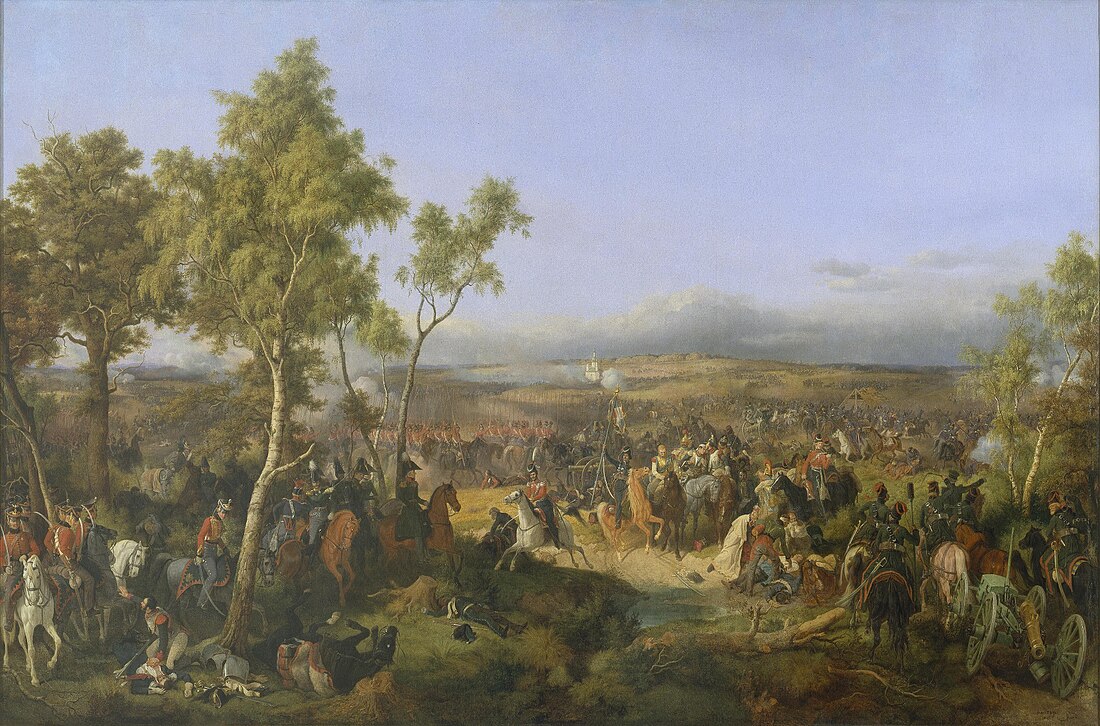Top Qs
Timeline
Chat
Perspective
Battle of Tarutino
1812 battle during the French invasion of Russia From Wikipedia, the free encyclopedia
Remove ads
The Battle of Tarutino (18 October 1812;[c] Russian: Тарутинское сражение) was a part of Napoleon's invasion of Russia. In the battle, Russian troops under the general command of Bennigsen (as part of Kutuzov's army), on instructions from Kutuzov, launched a surprise attack and defeated French troops under the command of Joachim Murat.[11][4][2] However, despite the pleas of Miloradovich and Yermolov, Kutuzov did not extend his own well-turned offensive, and Murat was not pursued as Bennigsen also did not decided on this with the available forces. The Russian infantry, stuffed with new recruits, performed heavy-handedly in this battle, and the Russians were also hampered by night delays. All this led to the Russians not being able to achieve greater success, despite their numerical superiority and surprise method. Tarutino battle led to a breakdown in relations between Kutuzov and Bennigsen, who lost his influence in the army for certain time.[12] In any event, the lost battle convinced Napoleon to commence the disastrous French retreat from Russia.
The battle is sometimes called the Battle of Vinkovo (French: Bataille de Winkowo) or the Battle of the Chernishnya (Russian: Сражение у реки Чернишни) after the local river. Many historians claim that the latter name is more fitting because the village of Tarutino was eight kilometres (5.0 mi) from the described events.
Remove ads
Preceding events
After the battle of Borodino, Kutuzov realized that the Russian army would not survive one more large engagement and ordered his soldiers to retreat to the south of Moscow to reinforce his army. At first it retreated in the south-east direction along the Ryazan road. When the army reached the Moskva River it crossed it and turned to the west to the Old Kaluga road. The army pitched camp in a village of Tarutino near Kaluga. At the same time small units of Cossacks continued moving along the Ryazan road misleading French troops under the command of Murat. When he discovered his error he did not retreat but made camp not far from Tarutino in order to keep his eye on the Russian camp, while Napoleon occupied Moscow.[13]
Remove ads
Battle
Summarize
Perspective
On 18 October 1812 Kutuzov ordered Bennigsen and Miloradovich to attack Murat's corps (20,000 men)[3] with two columns stealthily crossing the forest in the dead of night. Partisan detachments of Ivan Dorokhov and Aleksandr Figner to cut off the French retreat routes. Bennigsen's main force included three columns led by Vasily Orlov-Denisov, Karl Gustav von Baggehufwudt and Alexander Osterman-Tolstoy respectively. The other column was supposed to play an auxiliary role. In the darkness most of the troops got lost. By the morning only Cossack troops under the command of General Vasily Orlov-Denisov reached the original destination, suddenly attacked the French troops and captured the French camp with transports and cannons. Russian II and III Infantry Corps also had some success. When stronger forces of the Russians emerged from the forest, namely IV Infantry Corps, they came under French fire and suffered casualties, and since these Russian units came late the French were able to recover: the continuing disorder among the French was prevented by the appearance of Murat himself, and counterattacks by the French cavalry restored the balance. Murat was forced to retreat to escape being surrounded, but the Russian general Baggehufwudt was killed, while Bennigsen was concussed in the leg and he stopped an advance.[14][5] The French forces suffered at least 2,000 dead and wounded, 12 cannons, 20 caissons, 30 train-waggons had been taken, two generals killed,[9][10][15][7] the Russians lost 500 dead or more.[16][8][2]
Remove ads
Aftermath
Bennigsen and Kutuzov did not dare to continue to build on their success: Bennigsen did not want to continue the fight with the force he had, and Kutuzov disposed a withdrawal to the Russian camp to avoid encountering "a strong French reinforcement sent by Napoleon." In a letter to Alexander, Bennigsen blamed Kutuzov for everything, losing all of his influence in army (instead of answering the letter, Alexander simply forwarded it over to Kutuzov). But the battle was still a great victory for the Russians, boosting the morale of their forces, destroying valuable French cavalry units, and proving that Napoleon's once formidable army could be beaten on the battlefield. One day later, Napoleon started his own retreat from Moscow on 19 October 1812 southwards in direction of Kaluga.[17][12] The next major battle was the Battle of Maloyaroslavets.
Bennigsen would continue his service after Kutuzov's death in Bolesławiec on 28 April 1813; he would lead the so-called "Army of Poland" in the Wars of Liberation.
In popular culture
The battle is depicted in Leo Tolstoy's War and Peace. In the novel, Tolstoy claims that while the battle did not achieve any of its goals, it was exactly what the Russian army needed at the time, in that it exposed the weakness of the French army and gave Napoleon the push needed to begin his retreat.[18]
See also
Explanatory notes
- Old Style date: 6 October 1812
Notes
References
Sources
External links
Wikiwand - on
Seamless Wikipedia browsing. On steroids.
Remove ads


